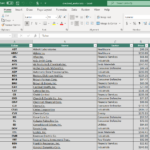Published on April 28th, 2025 by Bob Ciura
Spreadsheet data updated daily
We recommend long-term investors focus on high-quality dividend stocks. To that end, we view the Dividend Aristocrats as among the best dividend stocks to buy-and-hold for the long run.
The Dividend Aristocrats have a long history of outperforming the market when it comes to risk-adjusted returns. There are currently 69 Dividend Aristocrats.
You can download an Excel spreadsheet of all 69 Dividend Aristocrats (with metrics that matter such as dividend yields and price-to-earnings ratios) by clicking the link below:
Disclaimer: Sure Dividend is not affiliated with S&P Global in any way. S&P Global owns and maintains The Dividend Aristocrats Index. The information in this article and downloadable spreadsheet is based on Sure Dividend’s own review, summary, and analysis of the S&P 500 Dividend Aristocrats ETF (NOBL) and other sources, and is meant to help individual investors better understand this ETF and the index upon which it is based. None of the information in this article or spreadsheet is official data from S&P Global. Consult S&P Global for official information.
This article begins with an overview of the Dividend Aristocrats list. Then, we list our top 10 high growth Dividend Aristocrats.
The list below is comprised of 10 Dividend Aristocrats, all of which have raised their dividends for over 25 years in a row, and are included in the S&P 500 Index.
This article will list the 10 Dividend Aristocrats with the highest returns expected to come from earnings growth. This does not analyze expected total returns, but rather how much future earnings growth will factor into the expected total returns.
These 10 Dividend Aristocrats do not have high dividend yields today. But with their outsized dividend growth potential, these 10 Dividend Aristocrats are optimal dividend stocks to buy and hold for the long run.
Table of Contents
Dividend Aristocrats Overview
The requirements to be a Dividend Aristocrat are:
- Be in the S&P 500
- Have 25+ consecutive years of dividend increases
- Meet certain minimum size & liquidity requirements
All Dividend Aristocrats are high-quality businesses based on their long dividend histories. A company cannot pay rising dividends for 25+ years without having a strong and durable competitive advantage.
But not all Dividend Aristocrats make equally good investments today. That’s where the spreadsheet in this article comes into play. You can use the Dividend Aristocrats spreadsheet to quickly find quality dividend investment ideas.
The list of all 69 Dividend Aristocrats is valuable because it gives you a concise list of all S&P 500 stocks with 25+ consecutive years of dividend increases (that also meet certain minimum size and liquidity requirements).
A sector breakdown of the Dividend Aristocrats Index is shown below:


The top 2 sectors by weight in the Dividend Aristocrats are Industrials and Consumer Staples. The Dividend Aristocrats Index is tilted toward Consumer Staples and Industrials relative to the S&P 500.
These 2 sectors make up over 40% of the Dividend Aristocrats Index, but less than 20% of the S&P 500.
The Dividend Aristocrats Index is also significantly underweight the Information Technology sector, with a ~3.5% allocation compared with over 20% allocation within the S&P 500.
The following 10 Dividend Aristocrats have strong business models, durable competitive advantages, and long-term dividend growth potential.
High Growth Dividend Aristocrat #10: Genuine Parts Co. (GPC)
Genuine Parts has the world’s largest global auto parts network, with more than 10,800 locations worldwide. As a major distributor of automotive and industrial parts, Genuine Parts generates annual revenue of nearly $24 billion.


Source: Investor Presentation
It operates two segments, which are automotive (includes the NAPA brand) and the industrial parts group which sells industrial replacement parts to MRO (maintenance, repair, and operations) and OEM (original equipment manufacturer) customers.
Customers are derived from a wide range of segments, including food and beverage, metals and mining, oil and gas, and health care.
Genuine Parts posted fourth quarter and full-year earnings on February 18th, 2025, and results were better than expected on both the top and bottom lines. Adjusted earnings-per-share came to $1.61, which was six cents ahead of estimates.
Revenue was up 3.3% year-over-year to $5.8 billion, beating estimates by $90 million. The company noted acquisitions added 3.2% to sales, forex translation added 0.6%, and comparable sales fell 0.5%.
Click here to download our most recent Sure Analysis report on GPC (preview of page 1 of 3 shown below):


High Growth Dividend Aristocrat #9: Lowe’s Companies (LOW)
Lowe’s Companies is the second-largest home improvement retailer in the US (after Home Depot). It operates or services more than 1,700 home improvement and hardware stores in the U.S.
Lowe’s reported fourth quarter 2024 results on February 26th, 2025. Total sales came in at $18.60 billion compared to $18.55 billion in the same quarter a year ago.
Comparable sales increased by 0.2%, while net earnings-per-share of $1.99 compared to $1.77 in fourth quarter 2023.
Adjusted EPS was lower at $1.93. Lowe’s continues to be negatively impacted from a reduction in DIY discretionary spending.
The company repurchased 5.5 million shares in the quarter for $1.4 billion. Additionally, it paid out $650 million in dividends.
Lowe’s initiated its fiscal 2025 outlook and expects to earn diluted EPS of $12.15 to $12.40 on total sales of $83.5 to $84.5 billion.
Click here to download our most recent Sure Analysis report on LOW (preview of page 1 of 3 shown below):


High Growth Dividend Aristocrat #8: Emerson Electric Co. (EMR)
Emerson Electric is a diversified global leader in technology and engineering. Its global customer base and diverse product and service offerings afford it more than $17 billion in annual revenue.
Emerson posted first quarter earnings on February 5th, 2025, and results were mixed. Adjusted earnings-per-share came to $1.38, which was a dime ahead of estimates. Revenue was up 1.5% year-over-year to $4.18 billion, but missed estimates by $40 million.
Underlying sales rose 2%, and adjusted segment EBITDA margin was 28% of revenue, a 340-basis point improvement from the year-ago period. Gross profit reached a record level of 53.5% of revenue, supported by operational efficiencies, cost controls, and acquisition synergies.
Free cash flow was $694 million, up 89% year-over-year, with working capital improvements being the primary driver. Emerson’s backlog rose to $7.3 billion, excluding forex translation impacts.
Click here to download our most recent Sure Analysis report on EMR (preview of page 1 of 3 shown below):


High Growth Dividend Aristocrat #7: Ecolab, Inc. (ECL)
Ecolab Inc. is the global leader in water, hygiene, and energy technologies and services, with a presence in more than 170 countries.
The company operates in four major business segments: Global Industrial, Global Institutional, Global Healthcare and Global Pest Elimination.


Source: Investor Presentation
In mid-February, Ecolab reported (2/11/25) financial results for the fourth quarter of fiscal 2024. Organic sales grew 4% over the prior year’s quarter, primarily thanks to accelerated growth in the Industrial and Healthcare segments.
Thanks to higher volumes, material price hikes and lower supply chain costs, adjusted earnings-per-share grew 17%, from $1.55 to $1.81, and exceeded the analysts’ consensus by $0.01.
Moreover, thanks to robust pricing and new business wins, management provided strong guidance for 2025. It expects earnings-per-share of $7.42-$7.62, implying 13% growth over the prior year at the mid-point.
Click here to download our most recent Sure Analysis report on ECL (preview of page 1 of 3 shown below):


High Growth Dividend Aristocrat #6: Roper Technologies Inc. (ROP)
Roper Technologies is a specialized industrial company that manufactures products such as medical and scientific imaging equipment, pumps, and material analysis equipment.
Roper Technologies also develops software solutions for the healthcare, transportation, food, energy, and water industries. The company was founded in 1981, generates around $5.4 billion in annual revenues, and is based in Sarasota, Florida.
On January 30th, 2025, Roper posted its Q4 and full-year results for the period ending December 31st, 2024. Quarterly revenues and adjusted EPS were $1.88 billion and $4.81, indicating up 16% and 10% year-over-year, respectively.


Source: Investor Presentation
The company’s momentum during the quarter remained strong, with organic growth coming in at 7% and acquisitions driven growth coming in at 9%.
Organic growth was once again driven by broad-based strength across its portfolio of niche leading businesses. For the year, adjusted EPS grew by almost 10% to $18.31.
Backed by Roper’s growth momentum, balance sheet strength, and a large pipeline of quality acquisition opportunities, management believes Roper is well positioned for continued double-digit cash flow growth.
Further, Roper introduced its adjusted EPS guidance for FY2025, expecting it to land between $19.75 and $20.00.
Click here to download our most recent Sure Analysis report on ROP (preview of page 1 of 3 shown below):


High Growth Dividend Aristocrat #5: W.W. Grainger (GWW)
W.W. Grainger, headquartered in Lake Forest, IL, is one of the world’s largest business-to-business distributors of maintenance, repair, and operations (“MRO”) supplies.
Grainger has more than 4.5 million active customers, with more than 30 million products offered globally.
On January 31st, 2025, W.W. Grainger posted its Q4 and full-year results. For the quarter, revenues were $4.23 billion, up 5.9% on a reported basis and up 4.7% on a daily, constant currency basis compared to last year.
Results were driven by solid performance across the board. The High-Touch Solutions segment achieved sales growth of 4.0% due to volume growth in all geographies.


Source: Investor Presentation
In the Endless Assortment segment, sales were up 15.1%. Revenue growth for the segment was driven by core B2B customers across the segment as well as enterprise customer growth at MonotaRO.
Net income equaled $475 million, up 20.2% compared to Q4-2023. Net income was boosted by a 110 basis point expansion in the operating margin to 15.0%.
Earnings-per-share came in at $9.74, 22.8% higher year-over-year, and were further aided by stock buybacks. For the year, EPS reached a record $38.71.
Click here to download our most recent Sure Analysis report on GWW (preview of page 1 of 3 shown below):


High Growth Dividend Aristocrat #4: Nordson Corp. (NDSN)
Nordson was founded in 1954 in Amherst, Ohio by brothers Eric and Evan Nord, but the company can trace its roots back to 1909 with the U.S. Automatic Company.
Today the company has operations in over 35 countries and engineers, manufactures, and markets products used for dispensing adhesives, coatings, sealants, biomaterials, plastics, and other materials, with applications ranging from diapers and straws to cell phones and aerospace.


Source: Investor Presentation
On February 19th, 2025, Nordson reported first quarter results for the period ending January 31, 2025. For the quarter, the company reported sales of $615 million, 3% lower compared to $633 million in Q1 2024, which was driven by organic sales decrease of 9%, partly offset by a positive acquisition impact.
Medical and Fluid Solutions saw sales increase by 21%, while the Industrial Precision Solutions and Advanced Technology Solutions segments both had sales decreases of 11%. The company generated adjusted earnings per share of $2.06, a 7% decrease compared to the same prior year period.
Click here to download our most recent Sure Analysis report on NDSN (preview of page 1 of 3 shown below):


High Growth Dividend Aristocrat #3: Walmart Inc. (WMT)
Walmart traces its roots back to 1945 when Sam Walton opened his first discount store. The company has since grown into one of the largest retailers in the world, serving over 230 million customers each week.
Revenue will likely be around $600 billion this year.
Walmart posted fourth quarter and full-year earnings on February 20th, 2025, and results for Q4 were strong. Adjusted earnings-per-share came to 66 cents, which was a penny ahead of estimates for Q4.
Revenue was up 4.2% year-over-year to $180.6 billion, which beat estimates by $1.6 billion. Global ecommerce sales were up 16%, led by store-fulfilled pickup and delivery, as well as US marketplace.
The timing of Flipkart’s Big Billion Days sales event negatively impacted sales. The global advertising business grew 29%, with the US segment growing 24%.
Comparable sales excluding fuel were up 4.6% year-over-year, with transactions rising 2.8%, and average ticket rising 1.8%.
Online sales rose 20%, which contributed 2.9% of the overall 4.6% gain. Sam’s Club saw comparable sales rise 5.7%, and up 7.1% excluding fuel sales.
Click here to download our most recent Sure Analysis report on Walmart (preview of page 1 of 3 shown below):


High Growth Dividend Aristocrat #2: S&P Global Inc. (SPGI)
S&P Global is a worldwide provider of financial services and business information and revenue of over $13 billion.
Through its various segments, it provides credit ratings, benchmarks and indices, analytics, and other data to commodity market participants, capital markets, and automotive markets.
S&P Global has paid dividends continuously since 1937 and has increased its payout for 51 consecutive years.
S&P posted fourth quarter and full-year earnings on February 11th, 2025, and results were much better than expected on both the top and bottom lines.
Adjusted earnings-per-share came to $3.77, which was a staggering 30 cents ahead of estimates. Earnings rose from $3.13 a year ago.
Revenue was up 14% year-over-year to $3.59 billion, beating estimates by $90 million. The company posted revenue growth in all of its operating segments, in addition to strong operating margin expansion.
Operating expenses rose slightly from $2.26 billion to $2.33 billion year-over-year. That led to operating profit of $1.68 billion, sharply higher from $1.39 billion a year ago.
With dividend growth above 10%, SPGI is one of the rock solid dividend stocks.
Click here to download our most recent Sure Analysis report on SPGI (preview of page 1 of 3 shown below):


High Growth Dividend Aristocrat #1: Nucor Corp. (NUE)
Nucor is the largest publicly traded US-based steel corporation based on its market capitalization. The steel industry is notoriously cyclical, which makes Nucor’s streak of 52 consecutive years of dividend increases even more remarkable.
Nucor Corporation reported its fourth-quarter 2024 earnings on January 28, 2025, highlighting strong operational performance despite ongoing challenges in the steel industry.
The company posted net earnings of $287 million, or $1.22 per share, and $8.46 per share for the full year. EBITDA reached $751 million for the quarter and nearly $4.4 billion for the year.


Source: Investor Presentation
Nucor ended 2024 with $4.1 billion in cash, reflecting its robust financial position.
As a commodity producer, Nucor is vulnerable to fluctuations in the price of steel. Steel demand is tied to construction and the overall economy.
Investors should be aware of the significant downside risk of Nucor as it is likely to perform poorly in a protracted recession.
That said, Nucor has raised its base dividend for 52 straight years. This indicates the strength of its business model and management team.
Click here to download our most recent Sure Analysis report on NUE (preview of page 1 of 3 shown below):


Additional Reading
The Dividend Aristocrats are among the best dividend growth stocks to buy and hold for the long run. But the Dividend Aristocrats list is not the only way to quickly screen for stocks that regularly pay rising dividends.
We have compiled a reading list for additional dividend growth stock investing ideas:
Thanks for reading this article. Please send any feedback, corrections, or questions to [email protected].











































